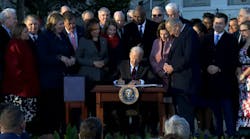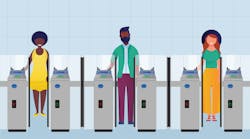OP-ED: Could the new infrastructure bill help transform the payments ecosystem?
President Joe Biden signed a sweeping multi-billion-dollar bipartisan infrastructure bill with implications for our entire transit system, from railroads to air travel. In it -- $39 billion set aside to help modernize public transit and make it more accessible and reliable for the people who depend upon it every day.
Now that the bill is signed, municipalities will be heads down determining how to best use these funds to improve the lives of their constituents. While much of the focus might be on maintaining the physical transit systems themselves, one opportunity that no city can afford overlook is the chance to modernize how people pay to ride. A modern, contactless open-loop payments system for local transit can open new opportunities for cities and ultimately drive better access for its people by allowing residents or visitors to tap to ride using the card or device already in their pockets.
Here’s what transit agencies need to know – and why they should plan to prioritize digital payments.
1. Public transit systems are at a unique crossroads.
Public transit took a hit in the early days of the pandemic. A new wave of public transit is just on the horizon and it’s going to be dominated by changing consumer needs. Paramount to them? The desire for an easy, secure and safe way to pay. Visa’s Future of Urban Mobility study found that 88 percent of surveyed riders globally expect contactless payment options on transit.
Coupled with this is the fact that people have relocated to suburbs and “exurbs” in droves and "The Great Resignation" has changed the map of the American workforce. People are going to have new needs of transit systems, whether they are further from their offices or have relocated entirely.
Transit systems are going to be faced with new riders that have new commuting patterns. What better way to ease the stress on these systems than to ensure the way people pay is consistent, no matter where they are traveling without having to manage balances or passes?
2. Why the cities win
Digital payments supply critical insights to public transportation operators and cities from a data standpoint, allowing them to deliver the greatest use of their resources to the greatest number of customers.
Digital payments can also support greener, more efficient operations. A pain point for many transport systems is how long it takes for riders to board and pay—known as “dwell time”—leading to a slower ride with long pauses. A study of bus emissions in Toronto, Canada found that the busiest bus routes with the longest passenger boarding had the highest emissions due to the large amount of dwell time. Contactless payments can help reduce dwell time significantly.
By creating an open, connected payment system, cities can potentially reduce ticketing costs, giving public transport operators a renewed focus on rider safety and satisfaction. Improving the customer experience and satisfaction helps grow ridership and revenue and the positive cycle continues.
3. Why the people win
Aside from offering consumers another payment option that is safe, easy and secure, tap-to-ride can drive habitual change around digital payments – not only increasing how much regular card holders choose to tap, but also bringing new people into the digital payments system.
By encouraging people to use contactless payments on a recurring basis, two things happen: first, those who already have access to the technology become more comfortable with the payment type and are more likely to use it in other scenarios. Visa research found that enabling tap to pay on transit systems resulted in more than a 15 percent lift in transactions from merchants in surrounding neighborhoods –a potential boon for local businesses.
But vitally, it can help bring people outside of the digital payments ecosystem into it in a comfortable and manageable way. According to a report by McKinsey Global Institute, one-third of the global population has no connection with secure banking services and the World Bank has talked about payments being “a gateway to other financial services, such as savings, credit, and insurance.” Transit could just be the ticket to engage this un-and under-banked population.
Cities looking to drive financial inclusion even more can pair new contactless tap-to-ride systems with education programs for the un- and under-banked to become better acquainted with digital payments.
This bill – the largest federal investment in public transit in history – will be vital in determining the future of our nation’s infrastructure and how the payments ecosystem can support it. Making room at the table for contactless payments on public transit can be a key tool to not only make people’s daily lives easier, but to creating a smarter, greener and safer transit system for everyone.
-------
Manolo Morales, senior director of US government relations with Visa

Manolo Morales | Senior Director of US Government Relations, Visa
Manolo Morales is a seasoned government affairs professional. His experience includes working in state government in California, as well as the healthcare, insurance and technology fields.





